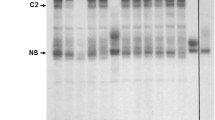Abstract
The long terminal repeat (LTR) of the mouse mammary tumor virus was used as a template to examine the dual binding parameters of the glucocorticoid-receptor (GR) and a repressor protein termed Inhibitory Factor 1 (IF1). The roceptor binds specifically to the glucocorticoid response element and precludes the binding of IF1 to its juxtaposed binding site within the LTR. When the two DNA targets are separated by the insertion of an additional 52 base pairs, coincident binding of both proteins is observed. Gel retention assays reveal three distinct nucleoprotein complexes. The first complex consists of the receptor and the LTR, the second is comprised of IF1 and DNA and the third is a multiprotein-DNA complex consisting of the GR, IF1 and DNA, migrating at a higher molecular weight position. The inhibition of IF1 binding by the presence of prebound GR leads to the repression of transcription of juxtaposed genes. The GR may act to block access of a sequence, used by the cell to titrate repressor proteins and facilitate the onset of gene expression. (Mol Cell Biochem122: 25–37, 1993)
Similar content being viewed by others
References
Majors J: The structure and function of retroviral long terminal repeats. Curr Top Micro 157: 50–59, 1990
Lee F, Mulligan R, Berg P, Ringold G: Glucocorticoids regulate expression of dihydrofolate reductase cDNA in a mouse mammary tumor virus chimaeric plasmids. Nature 294: 228–232, 1981
Huang AL, Ostrowski MC, Berard D, Hager GL: Glucocorticoid regulation of the Ha-MuSV p21 gene conferred by sequences from mouse mammary tumor virus Cell 27: 245–255, 1981
Yamamoto KR: Steroid receptor regulated transcription of specific genes and gene networks. Ann Rev Genet 19: 209–252, 1985
Cordingley MG, Riegel AT, Hager GL: Steroid-dependent interaction of transcription factors with the inducible promoter of mouse mammary tumor virusin vivo. Cell 48: 261–270, 1987
Kuo W-L, Vilander LR, Huang M, Peterson DO: A transcriptionally defective long terminal repeat within an endogenous copy of mouse mammary tumor virus proviral DNA. J Virol 62: 2394–2402, 1988
Richard-Foy H, Hager GL: Sequence-specific positioning over the steroid inducible MMTV promoter. EMBO J 6: 2321–2328, 1987
Perlmann T, Wrange O: Specific glucocorticoid receptor binding to DNA reconstituted in a nucleosome. EMBO J 7: 3073–3079, 1988
Piña B, Brüggemeier U, Beato M: Nucleosome positioning modulates accessibility of regulatory proteins to the mouse mammary tumor virus promoter Cell 60: 719–731, 1990
Archer TK, Cordingley MG, Wolford RG, Hager GL: Transcription factor access is mediated by accurately positioned nucleosomes on the mouse mammary tumor virus promoter. Mol Cell Biol 11 2: 688–698, 1991
Li H-L, Kmiec EB: A glucocorticoid response element enhances transcription of a methionine tRNA genein cis andtrans. Mol Endo 4: 1173–1182, 1990
Sekiguchi JM, Kmiec EB:Cis-acting enhancement of RNA polymerase III gene expressionin vitro. Mol Gen Genet 221: 435–442, 1990
Carballo M, Beato M: Binding of glucocorticoid receptor induces a topological change in plasmids containing the hormone response element of mouse mammary tumor virus. DNA and Cell Biol 9: 519–525, 1990
Perlmann T: Glucocorticoid receptor DNA binding specificity is increased by the organization of DNA in nucleosomes. Proc Natl Acad Sci USA 89: 3884–3888, 1992
Ruberti I, Worcel A: Mechanism of chromatin assembly in Xenopus oocytes. J Mol Biol 189: 457–476, 1986
Crosten GE, Kerrigan LA, Lira LM, Marshak DR, Kadonaga JT: Sequence-specific antirepression of histone H1-mediated inhibition of basal RNA polymerase II transcription. Science 251: 643–650, 1991
Diamond M, Miner JN, Yoshinaga SK, Yamamoto KR: Transcription factor interactions: Selectors of positive or negative regulation from a single DNA element. Science 249: 1266–1272, 1990
Siddique HR, Sarkar NH: The interaction of a c-jun/fos related protein factor with the U3 sequences of the mouse mammary tumor virus LTR. Bioch Biophys Rsch Comm 172: 348–360, 1990
Miner JN, Yamamoto KR: Regulatory crosstalk at composite response elements. TIBS 16: 423–426, 1991
Peterson DL, Beifuss K, Morely KL: Context-dependent gene expression:Cis-acting negative effects of specific plasmid sequences on eukaryotic genes. Mol Cell Biol 7: 1563–1567, 1987
Razvi F, Garguilo G, Worcel A: A simple procedure for parallel sequence analysis of both strands of 5′-labeled DNA. Gene 23: 175–183, 1983
Sekiguchi JM, Swank RA, Kmiec EB: Changes in DNA topology can modulatein vitro transcription of certain RNA polymerase III genesin vitro. Mol Cell Biochem 85: 123–133, 1989
Glikin G, Ruberti I, Worcel A: Chromatin assembly in Xenopus oocytes:In vitro studies. Cell 37: 33–41, 1984
Kmiec EB, Sekiguchi JM, Cole AD: Studies on the ATP requirement ofin vitro chromatin assembly. Biochem Cell Biol 67: 443–454, 1989
Sinden RR, Carlson JO, Pettijohn DE: Torsional tension in the DNA helix measured with trimethyl psoralen in livingE. coli cells: Analogous measurements in insects and human cells. Cell 21: 773–783
Author information
Authors and Affiliations
Rights and permissions
About this article
Cite this article
Ye, S., Kmiec, E.B. The glucocorticoid receptor precludes the binding of a transcriptional repressor protein to the long terminal repeat of the mouse mammary tumor virus. Mol Cell Biochem 122, 25–37 (1993). https://doi.org/10.1007/BF00925734
Received:
Accepted:
Issue Date:
DOI: https://doi.org/10.1007/BF00925734




